
* This chapter provides a description of the origins of the F-15, its primary technical features, and F-15 variants.
* In 1965, the USAF began studies for a "Fighter Experimental (FX)" to replace the Air Force's current first-line fighter, the McDonnell Douglas (MDD) F-4 Phantom, leading to an issue of a request for proposals to the US aviation industry in 1966 for an ambiguously-named "Tactical Support Aircraft". Several manufacturers submitted proposals, but they were not followed up at the time.
The effort did lead to a second RFP in February 1968. In that time the Air Force had learned some lessons from air combat over Vietnam that showed existing fighters like the F-4 left something to be desired, and also had become aware of new Soviet threat aircraft, such as the Mikoyan MiG-25 "Foxbat", that the F-4 could not hope to deal with. The Air Force saw the FX from the outset as a long-range air-superiority fighter, engaging adversary aircraft from "beyond visual range (BVR)" with AIM-7 Sparrow air-to-air missiles (AAM). The fighter would also be capable of close-in combat, and would have a (strictly secondary) strike capability.
The 1968 RFP elaborated on this by specifying a twin-engine, single-seat fighter with a built-in cannon, the omission of which was found to be a major fault with the F-4; a ferry range long enough to permit self-deployment to Europe without tanker support; and a top speed of Mach 2.5. There had been a push to specify a two-seat aircraft in the RFP, but the single-seat configuration won out -- though the two-seat configuration would also be built for operational conversion. The Mach 2.5 spec now seems extreme, a reflection of the infatuation with raw speed that lingered through the 1960s, coupled with fear of being outclassed by the Foxbat and other new Soviet fighters. The RFP also called for self-contained engine starting, good pilot field of view, easy maintenance, and a take-off weight of no more than 18,150 kilograms (40,000 pounds).
Most American aircraft manufacturers submitted proposals, with the field whittled down to McDonnell Douglas, North American, and Fairchild Republic by the end of 1968. The competition was won by MDD a year later, on 23 December 1969. The initial contract specified delivery of:
The first ten F-15As were referred to as "Category I" machines, while the following eight F-15As were referred to as "Category II" machines.
* The MDD F-15 design team was led by George Graff, though early design work owed much to Herman Barkey, who had led the design effort for the F-4. Program management was under Don Malvern, also a veteran of the F-4 effort.
The design work was assisted by the construction of three 3/8ths-scale unpowered drone versions of the fighter. These robots were referred to as "remotely piloted research vehicles (RPRVs)" and were taken aloft over Edwards Air Force Base (AFB) in California by the US National Aeronautics & Space Administration's (NASA) NB-52A carrier aircraft, to be released at high altitude. They would glide back to earth, to land on retractable skids on the dry lakebed at Edwards. The RPRVs could also be fitted with a parachute to be "snagged" by a helicopter in flight for recovery. Each drone weighed 1,099 kilograms (2,425 pounds), and had a length of 7.01 meters (23 feet). They were made of aluminum, wood, and fiberglass, with a cost of only $250,000 USD each. They provided extremely valuable flight data, the exercise being regarded as very useful and cost-effective.
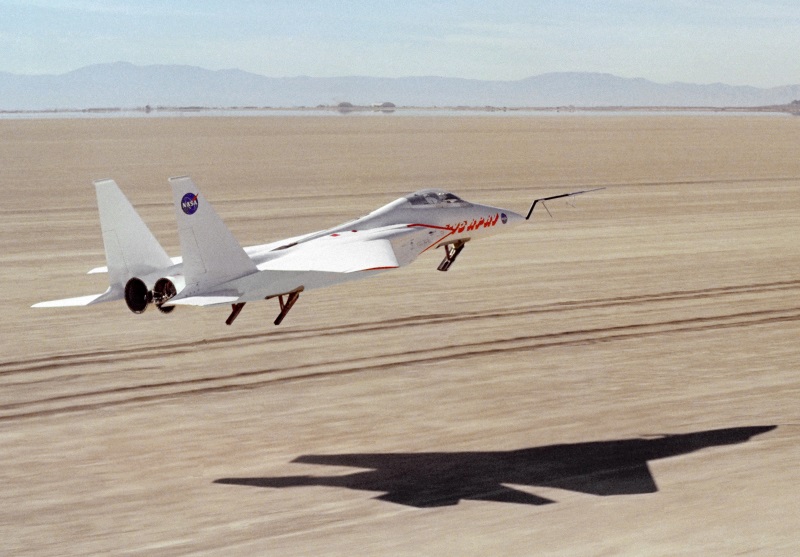
The first Category I F-15A was rolled out at Saint Louis on 26 June 1972. It was broken down, loaded onto a Lockheed C-5A cargolifter, flown to Edwards AFB, and then reassembled to perform its first flight on 27 July 1972. MDD chief test pilot Irving Burrows was at the controls, and the flight was uneventful. The initial flight of the first two-seater was on 7 July 1973.
All twenty of the test and evaluation machines flew in neat light-blue overall colors, and in the early days of flight testing of the Category I machines had high-visibility dayglow orange paint applied to the wingtips and other selective elements to make them easier to observe. Many of these aircraft would go on to have extensive careers in the test and trials role. In 1976, the second TF-15A was painted in patriotic red-&-and-blue colors for the American bicentennial and sent on a world promotional tour, which included an impressive display at the Farnborough Air Show in the UK.
* Manufacture of an initial batch of 30 full-production F-15s was announced on 1 March 1973, leading to initial service delivery in September 1974 and introduction to operational service in January 1976. By that time, the type had acquired its formal name of "Eagle". While formal names have a habit of being ignored by aircrews in favor of less formal and occasionally irreverent nicknames, in this case the "Eagle" name appears to have stuck fairly well.
In April 1974, the Air Force ordered the modification of the 17th F-15A built to the "Streak Eagle" configuration, stripping the aircraft of nonessentials, even most of the paint, to set a string of flight records in 1974 and 1975. The Streak Eagle weighed 815 kilograms (1,800 pounds) less than a production F-15A, and flew with no more fuel than was safely required to perform a given flight exercise.
The Streak Eagle effort cost the US taxpayer over $2 million USD, but the Air Force regarded it as money well spent to promote the F-15 program; determine what the machine was really capable of; sell the type to pilots on the front line; and intimidate the Soviets. The Soviets had already been intimidated by the FX program, and as the Streak Eagle broke records held by the Soviet MiG-25 Foxbat, saw their worst fears coming true. The USSR pushed on to develop their answer to the F-15, the Sukhoi Su-27 "Flanker", and a stripped Su-27 would eventually take most of the records back away from the Streak Eagle.
As far as inspiring the troops went, the Streak Eagle proved what F-15 pilots would soon find out for themselves: nothing then flying could outclimb the Eagle. A total of 355 full production F-15As was built, as well as 57 "F-15Bs", as the two-seater was known in service. No F-15A/Bs were built new for foreign users, but some development machines and USAF aircraft would be passed on to other countries.
BACK_TO_TOP* The F-15A was a big aircraft, inevitably so given its load and range requirements, featuring a central fuselage with Pratt & Whitney F100-PW-100 afterburning bypass jet engines on each side; wedge-shaped clipped wings with a sweep of 45 degrees; all-moving tailplanes; twin tailfins; and tricycle landing gear. Each of the two engines provided 65.26 kN (6,650 kgp / 14,670 lbf) maximum dry thrust and 106 kN (10,800 kgp / 23,830 lbf) afterburning thrust. The aircraft consisted of 37.3% aluminum, 25.8% titanium, and 5.5% steel by weight, with selective use of composite materials.
___________________________________________________________________
MCDONNELL DOUGLAS F-15A EAGLE:
___________________________________________________________________
wingspan:
13.05 meters (42 feet 10 inches)
wing area:
56.48 sq_meters (608 sq_feet)
length:
19.43 meters (63 feet 9 inches)
height:
5.63 meters (18 feet 6 inches)
empty weight:
12,975 kilograms (28,600 pounds)
normal take-off weight:
18,885 kilograms (41,500 pounds)
MTO weight:
25,400 kilograms (56,000 pounds)
max speed at altitude:
2,655 KPH (1,650 MPH / 1,435 KT)
service ceiling:
18,300 meters (60,000 feet)
ferry range with tanks:
4,630 kilometers (2,880 MI / 2,500 NMI)
___________________________________________________________________
The engines were fed by wedge-style inlets that "nodded" up and down hydraulically to optimize airflow. The engines were mounted close together to reduce handling problems due to asymmetrical power if one engine failed; they were separated by a titanium keel to prevent the failure of one engine from taking out the other. An engine could be swapped out in less than a half-hour. The engines were not "handed", with both rotating in the same direction. There was a Garrett auxiliary power unit (APU) between the engines, just behind the fan intakes, for engine starting and ground power.
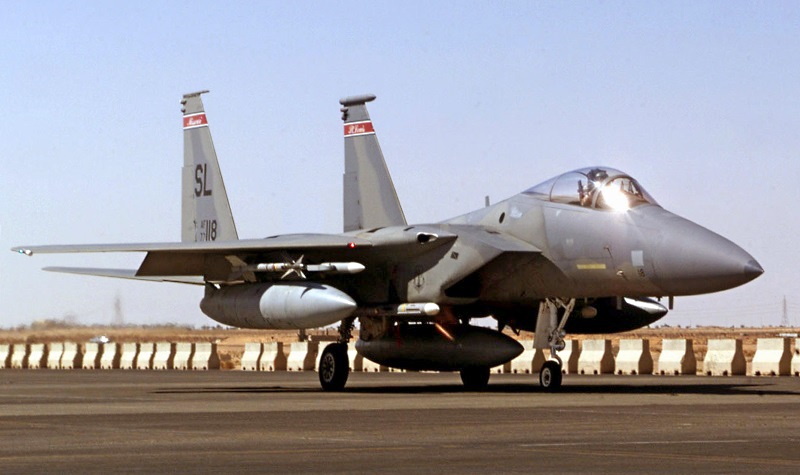
The large-area wings, sometimes referred to as the "tennis court", gave low wing loading and excellent agility for such a big aircraft. They had outboard ailerons and inboard two-position flaps, but there were no high-lift schemes such as leading-edge slats, flaps, or a blown-flaps system, since the big wing provided good low-speed handling without them.
The wings had three spars and the aircraft could still fly even if one of the spars was shot away. The Eagle's outstanding aerodynamics allowed it to stay in the air even with a loss of a substantial portion of a wing. In 1983, one Israeli F-15 actually lost all but a stub of one wing in a mid-air collision during training -- to still land safely, being repaired and returned to service. The wings of the prototypes had a slightly wider span than production machines.
A hydraulically-operated airbrake was mounted on the aircraft's spine. It was very large, being sometimes referred to as the "barn door"; apparently development Eagles had a smaller airbrake. The tailplanes had a "dogtooth" that was introduced in development to cure flutter problems. A single tailfin was considered up to a late stage of development, but twin tailfins were judged a better bet in terms of maneuverability and survivability.
All the landing gear had single wheels, with all gear retracting forward. There was a runway emergency arresting hook under the tail just forward of the exhausts. The Eagle featured a triple-redundant hydraulic system and a dual-redundant electrical system. Large numbers of access panels were fitted to ease maintenance. The number of lubrication points was only 202, compared to the F-4's 510, and similar simplifications were obtained with other critical aircraft elements.
* The F-15A's main combat sensor was the long-range Hughes AN/APG-63 coherent pulse-Doppler radar, designed specifically for the Eagle. The AN/APG-63 provided a "look-down / shoot-down" capability to allow the fighter to engage low-altitude targets in "ground clutter". It also provided multiple operating modes for air-to-air combat, ground mapping for navigation, and "identification friend or foe (IFF)" interrogation.
The F-15A included a countermeasures suite, including an AN/ALR-56 radar warning receiver (RWR), an AN/ALQ-128 EW warning system, and a Northrop AN/ALQ-135 built-in jamming system. Of course radios and electronics navigation gear, such as TACAN and a Litton AN/ASN-109 inertial navigation system (INS), were fitted as well. The pilot flew the machine through an analog electronic "fly by wire (FBW)" system named the "Control Augmentation System (CAS)"; the aircraft could still be flown if the CAS was disabled.
The F-15A's cockpit instrumentation was analog, but featured a head-up display (HUD) and "hands on throttle and stick (HOTAS)" controls. The pilot sat on an MDD Escapac IC-7 ejection seat under a blown clamshell canopy that hinged open from the rear. The canopy provided an excellent all-round field of view. Pilots were really excited with the cockpit arrangement -- which had been designed by a team under MDD engineer Eugene Adams -- saying they felt like they weren't so much sitting in an F-15 as riding on top of it.
* The F-15 featured built-in armament in the form of a General Electric (GE) 20-millimeter M61A1 Vulcan six-barreled Gatling cannon mounted in the right wingroot, with 920 rounds of ammunition and a rate of fire of 6,000 rounds a minute. Work was performed to develop a 25-millimeter cannon designated the "GAU-7" firing caseless cartridges for the F-15, but the project was canceled in 1973, due to technical difficulties; the Air Force fell back to the well-proven and highly effective Vulcan.
There was a centerline stores pylon and a stores pylon under each wing, for a total of three pylons. Typical external stores included:
That gave a maximum total external load of four Sparrows, four Sidewinders, and three external tanks. There was an inflight boom refueling socket in the left wingroot.
The F-15B had tandem seats, with the back-seater in a raised position to give a better forward view, and a back-hinging clamshell canopy. Dimensions were the same as the F-15A, but the F-15B weighed 364 kilograms (800 pounds) more. The F-15B was fully combat-capable, though it did lack the built-in AN/ALQ-135 jammer of the F-15A.
* Although the first Eagles delivered to the USAF were painted in an overall "air superiority blue" color scheme, much like that applied to the twenty development aircraft, it turned out to be ineffective as camouflage in the gray skies over Europe; the service quickly turned to a two-tone gray scheme known as "Compass Ghost". Four "splinter" camouflage schemes, involving angular patterns intended to confuse the outline of the aircraft, were also tested in 1977 but not adopted. The splinter patterns were designed by the well-known aviation artist Keith Ferris. Apparently the exercise led to a legal dispute between Ferris and the Air Force, but the details are unclear.
In any case, pilots were pleased to get their hands on the powerful, fast, and agile F-15, but there were some teething problems to be worked out in service. There were bugs with both the AN/APG-63 radar and the P&W F100 engines. The F100 problems were particularly frustrating, with the Air Force claiming (in public) that they didn't meet specification, and that Pratt & Whitney wasn't being responsive in fixing the problems -- while P&W engineers muttered that the problems were largely due to slipshod Air Force maintenance procedures, and that the USAF was ignoring suggestions for fixes. Determining the facts in the case is treacherous, something along the lines of being caught in a dispute between two elephants, and basically irrelevant anyway: in the end the problems were resolved, one way or another, and the F100 became an outstanding engine. Other improvements were added to the F-15A/B, as discussed later.
BACK_TO_TOP* Even as the F-15A/B was building up numbers in USAF service, MDD engineers were considering a set of comprehensive improvements to the Eagle under the "Production Eagle Package 2000 (PEP-2000)" effort. The result of this exercise, the "F-15C", performed its initial flight on 27 February 1979. An equivalent improved version of the two-seat F-15B, designated the "F-15D", was introduced as well, performing its first flight on 19 June 1979.
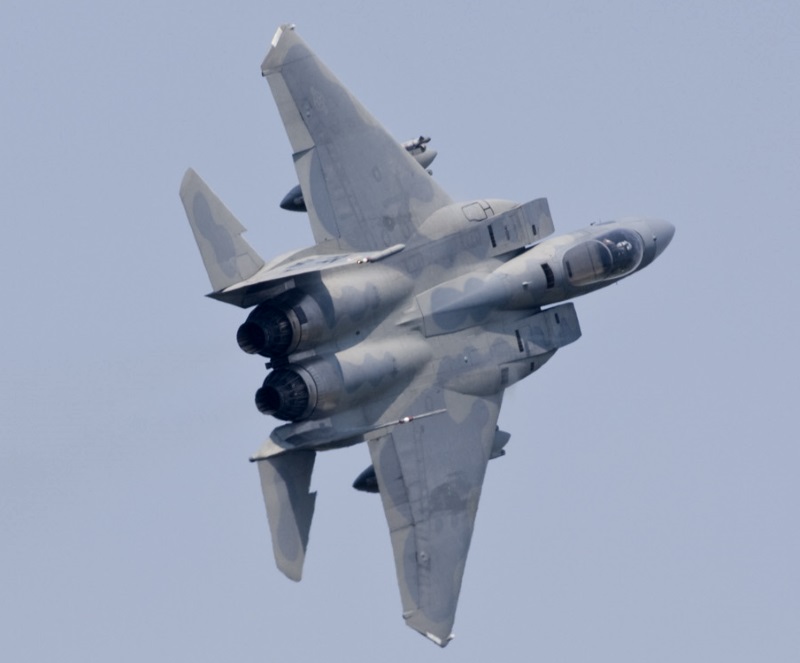
With one significant exception, the changes between the F-15A and the F-15C were difficult to spot. Both retained the same general configuration and external payload capability. Changes in the F-15C included:
The changes to the F-15C added about 272 kilograms (600 pounds) to the empty weight. F-15C/Ds began to go into service in the fall of 1979. A total of 408 F-15Cs and 62 F-15Ds was built for the USAF, plus more built for foreign users and discussed later. As the F-15C/Ds were phased into service, F-15A/Bs were passed on to US Air National Guard (ANG) units. The F-15C/D was the basis for the Japanese "F-15J/DJ", license-built in Japan by Mitsubishi. The Japanese variants are discussed in the next chapter.
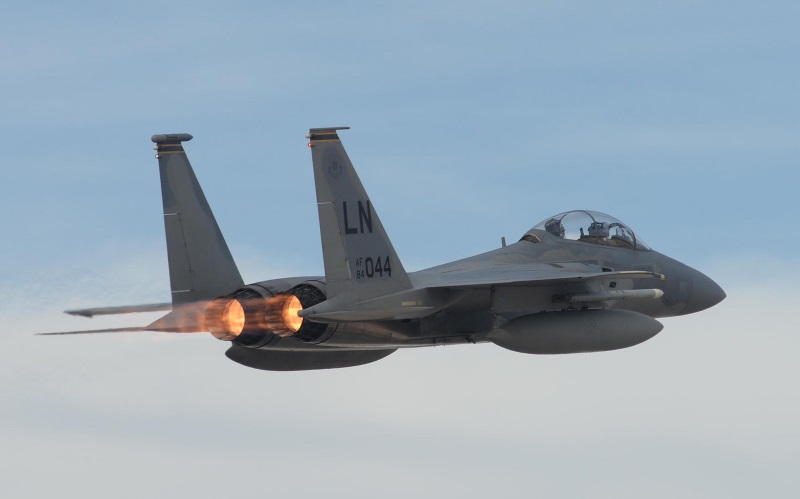
* In the mid-1980s, the USAF began to move forward on a "Multi-Stage Improvement Program II (MSIP II)" effort for the F-15C/D. A similar "MSIP I" was defined for the F-15A/B, but abandoned as not cost-effective.
The centerpiece of MSIP II was the advanced AN/APG-70 radar, a next-generation descendant of the AN/APG-63, with the same antenna but much-improved capabilities and a range of operating modes. It featured "low probability of intercept" capabilities, allowing it to sense targets without being picked up by hostile radar warning receivers. The cockpit layout was also improved, featuring:
The MSIP II configuration was initially evaluated on an F-15C in December 1984 and was rolled into production in June 1985. Older F-15C/Ds were gradually upgraded.
* Although the MSIP I update program for the F-15A/B was abandoned, some F-15A/Bs were provided with a subset of the F-15B/C update, featuring such items as the stronger landing gear of the F-15C/D, F100-PW-220E engines, and improved Raytheon AN/APG-63(V)1 radar, discussed later. These updated F-15A/Bs cannot carry conformal fuel tanks.
BACK_TO_TOP* A big aircraft like the Eagle was obviously capable of carrying a heavy warload of bombs and other air-to-surface ordnance, and as mentioned the original concept for the aircraft included a secondary strike capability. The Air Force dropped that requirement in 1975.
Early F-15s were delivered with the wiring to carry air-to-surface ordnance, apparently even free-fall nuclear weapons, but the F-15A/B and F-15C/D didn't have the software to support the mission, and the wiring was deleted in later production. Development F-15s were fitted with bomb racks on the centerline pylon and each wing pylon, allowing carriage of, say, six 225-kilogram (500-pound) bombs on each pylon for a total warload of 18 bombs -- but such stores were not carried by operational Eagles. Late in Eagle development there was a slogan: "Not a pound for air-to-ground!"
That was not snobbery; having obtained an excellent air-superiority fighter, the Air Force was reluctant to do anything to suggest to Congress that the Eagle could or should be shoe-horned into a multirole configuration that would compromise its air-to-air combat capabilities. Still, something as big and powerful as the F-15 clearly had potential as a strike aircraft, and in the late 1970s MDD went to the USAF with proposals for a "Strike Eagle". The Air Force bought the pitch; in 1978, General Wilbur Creech, head of the USAF Tactical Air Command, ordered a study of the Strike Eagle under the "Enhanced Tactical Fighter (ETF)" program, which later became the "Dual Role Fighter (DRF)" program.
Officially, the DRF was supposed to be a supplement or replacement for the General Dynamics F-111 Aardvark, but it seems Creech was more concerned about possible problems with the development program for the Lockheed F-117 Stealth Fighter and was after an alternative. While Congress traditionally takes a skeptic's viewpoint on the armed services shopping around for new weapons when items that seem like solutions are available or in the pipeline, the F-117 was so secret that very few politicians or Washington bureaucrats knew about it. Although the F-111 had a nightmarish development history, the F-111F was an excellent aircraft, and initially the DRF study recommended the purchase of more F-111Fs. However, for reasons that were a bit controversial, the final result was a recommendation to acquire the Strike Eagle or some other new aircraft instead.
In any case, MDD used company funds to modify the hard-working second TF-15A to Strike Eagle configuration, performing its first flight in that configuration on 8 July 1980. The Air Force then conducted a competition between the Strike Eagle and the General Dynamics "F-16F" (better known as the "F-16XL"), a heavily modified stretched F-16 with a "cranked arrow" double-delta wing.
The Strike Eagle was joined in the effort by an F-15C and F-15D fitted for various trials. MDD won the USAF contract on 24 February 1984, leading to a production order for the "F-15E". Although the F-16XL was an outstanding machine, the USAF judged that the Strike Eagle was a less risky option, and that its twin-engine configuration made it more survivable than the single-engine F-16XL.
The first production F-15E performed its initial flight on 11 December 1986. It was painted overall charcoal gray, which would become the standard color scheme for the Strike Eagle. Initial delivery to the USAF was on 12 April 1988, leading to initial operational capability in 1989.
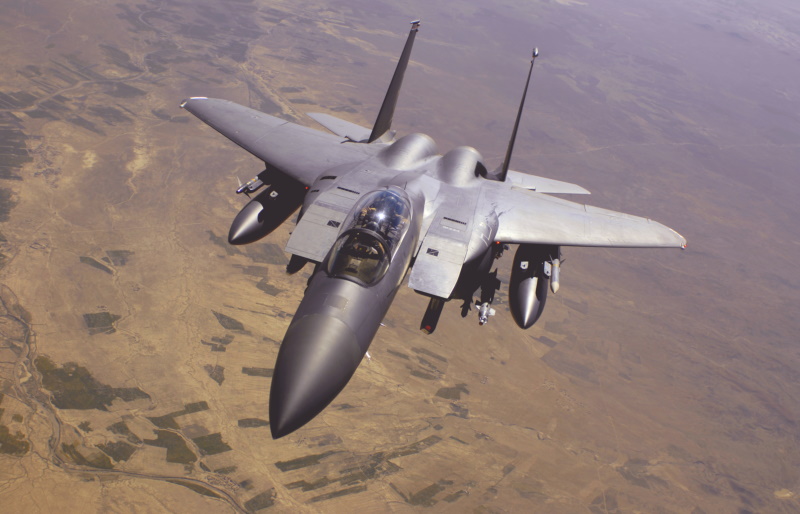
The Air Force did not officially adopt the "Strike Eagle" name, but it survived as at least an informal description of what the machine was. Aircrew have called it the "Beagle (Bomb Eagle)", "Mudhen" (at least partly because of the muddy color), or simply the "E". Apparently not all the nicknames are meant as compliments, since there seems to be a bit of a class snobbery among USAF pilots, with the strike role held in lower esteem than air-superiority. One other nickname, "WartEagle", seems clearly snide, comparing the F-15E to the slow, unarguably ugly (if extremely effective and tough) Fairchild A-10 "Warthog" close-support aircraft.
* All F-15Es were two-seaters, with the rear cockpit optimized for a "weapons system operator" -- "WSO" or "whizzo". The F-15E was a true "second generation" Eagle, featuring a number of significant improvements over the F-15C/D, including:
Although the first 134 production F-15Es retained the F100-PW-220 engines of the F-15C/D, later production featured the substantially uprated F100-PW-229 "Improved Performance Engine (IPE)" with an improved digital electronic engine control; 79.2 kN (8,070 kgp / 17,800 lbf) max dry thrust; and 129.5 kN (13,150 kgp / 29,000 lbf) afterburning thrust.
Many Strike Eagles with the F100 IPE were fitted with an "Automatic Thrust Departure Prevention System (ATDPS)" that automatically reduced thrust in one engine if another failed, reducing the chance that asymmetric thrust might toss the aircraft into a spin or cause structural damage. ATPDS was introduced because this risk had been enhanced by the installation of the more powerful F100 IPE.
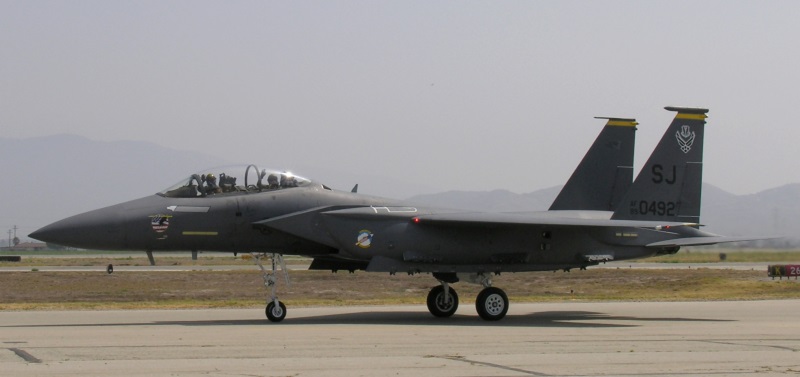
The F-15E was designed to accommodate either the P&W F100 IPE engine or the roughly comparable General Electric F110 IPE engine. The US Air Force never bought the GE F110 for the F-15, though one F-15E was put through trials with the GE engines. Some sources claim that the GE F110 IPE is substantially more reliable and less maintenance-intensive than the P&W F100 IPE, but this may just be a lingering effect of the controversy over the early service of the F100. There was apparently talk of re-engining some in-service F-15Es with the GE F110 IPEs, but if so the Air Force did not proceed with that plan.
Conformal fuel tanks were carried by Strike Eagles from the start. They could be removed, but the Strike Eagle's CFTs were modified to provide most of the aircraft's stores attachments, making the aircraft ineffective in the strike role if the tanks were pulled off. Each of these "Dash-4" CFTs featured a row of three stub pylons, each capable of carrying a single mid-sized store such as a 225-kilogram (500-pound) bomb, in an upper position, and a continuous rail in a lower position. The rail could be fitted with shackles to carry three mid-sized bombs; two AAMs; or one or two heavy stores.
The heavy stores that could be carried on the lower position included big "bunker buster" LGBs or the B61 "Silver Bullet" nuclear weapon, which had a variable yield that could be set from a few tens to hundreds of kilotons of explosive yield. Incidentally, it is unclear if a "Dash-2" CFT was ever actually built, and though a "Dash-3" CFT did reach the trials stage, it did not reach service.
The traditional centerline pylon and single wing pylons, with their side-mounted AAM launch rails, were retained. Triple ejector racks could be fitted to the wing pylons to carry AGM-65 Maverick air-to-surface missiles. The centerline pylon could be used to carry an AN/AXQ-14 datalink pod to guide electro-optical munitions such as the GBU-15 electro-optic glide bomb (EOGB) series or the similar AGM-130 rocket-boosted bomb. Imagery from the weapon's seeker was relayed back through the pod to the WSO's displays, with the WSO then steering the bomb into the target. The pilot could also use LANTIRN for navigation, as well as perform targeting in a pinch. There was a stub pylon under each engine intake for mounting the LANTIRN pods. Maximum external load was 11,100 kilograms (24,000 pounds).
* Although the initial requirement for the F-15E envisioned a buy of 392 aircraft, a total of 209 F-15Es was obtained by the USAF from the main production build. This was followed beginning in the late 1990s by three batches of attrition replacement machines totaling 27 aircraft, for a final tally of 236 USAF F-15Es.
The Strike Eagle proved highly capable, though critics claimed that it could not carry as much warload as the F-111 it replaced and that its low wing loading gave a bumpy and tiring ride at low level. One F-15 aircrewman responded, if not necessarily with the last word, but certainly persuasively:
BEGIN_QUOTE:
The criticisms of the big wing are unfounded. We flew the F-111, which was unbelievably stable at low level. It was a fear for us that the F-15E with its low wing loading was going to be rough, but we've found it surprisingly stable. The big wings make the ride a little bit rougher, but I'd take the old wing loading of this airplane over my old job in terms of capability. You notice it bumps around a little more, but when I can turn around and kill someone because of that same wing, I'll gladly trade it. In the end, I'll take a little bit bumpier ride.
END_QUOTE
Incidentally, Strike Eagles do not always fly with CFTs. They are draggy, and are removed on ferry flights of up to moderate range that do not require max fuel. They also degrade maneuverability and are taken off when F-15Es are pressed into the air-patrol mission.
Since F-15C/D ended production in 1992, the F-15E has been the basis for new foreign F-15 sales, including the Israeli "F-15I", the Saudi "F-15S/SA", the Qatari "F-15QA", and the South Korean "F-15K". These variants are discussed later.
BACK_TO_TOP* From early in its career, the F-15 has been improved to keep the aircraft current and effective. New weapons were qualified, including the AIM-120C AMRAAM and AIM-9X Sidewinder AAMs; the Global Positioning System (GPS) guided "Joint Direct Attack Munition (JDAM)" and "Joint Stand-Off Weapon (JSOW)" glide bombs; the Harpoon antiship missile; and the AGM-130 or AGM-142 standoff weapons. JDAM has proven highly popular in recent combat service.
Another very useful addition was a datalink. The JTIDS datalink, as mentioned, was canceled, but the requirement didn't go away. In the early 1990s the US began a collaborative program with several European nations to begin development of the "Multifunction Information Distribution System -- Low-Volume Terminal (MIDS-LVT)" for the F-15C/D and other aircraft to provide a secure, high-bandwidth datalink for communications between NATO aircraft and other systems.
The F-15E was to receive a less sophisticated unit derived from MIDS-LVT, designated the "Fighter Data Link" -- "FDL" AKA "Fiddle" -- based on the "Link-16" standard, but this was originally a lower priority effort. However, in 2001, with the need to support the US intervention in Afghanistan, the F-15E jumped to the top of the priority queue. Afghanistan put heavy demands on strike elements, while air superiority was barely an issue. The entire Strike Eagle fleet was equipped with FDL in about a year, with the F-15C/D LVT installation lagging well behind. The F-15 community found the datalink very valuable, but not necessarily to be used to justify attacks without corroboration from some other source.
A high-bandwidth datalink pod, the "AN/ZSW-1 Improved Data Link Pod (IDLP)" was also fielded for the Strike Eagle in the late 1990s as part of the "Gold Pan" system. The pod linked to the aircraft through AN/AXQ-14 EOGB datalink interface and was used to upload targeting data and imagery.
Other improvements have been added to the F-15 fleet:
The Strike Eagle's LANTIRN targeting pod underwent its own series of upgrades, but has been replaced by the Lockheed Martin AN/AAQ-33 Sniper pod, which provided improved sensors with greater zoom capabilities and a stabilization system to allow targeting from greater standoff ranges. At last notice, the LANTIRN navigation pod was still in use.
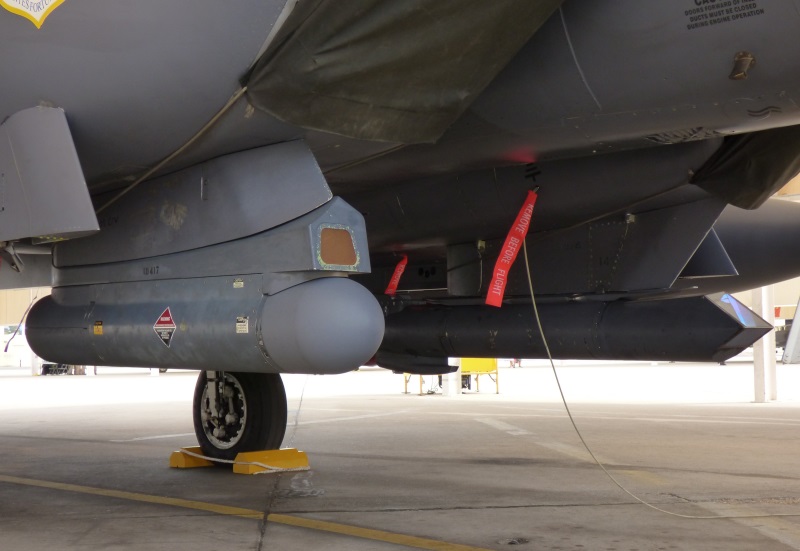
* Further improvements have been added as money and priorities permit. The AIM-9X Sidewinder AAM is an "off-boresight" missile that can engage a target aircraft without the launch aircraft flying straight at the target to get a "lock" with the missile's heat seeker head. Off-boresight operation instead uses a "helmet-mounted sight" in which the pilot simply looks at the target and indicates that the missile get a lock on it. A "Joint Helmet Mounted Cueing System (JHMCS)" was put into production in 2001 and was initially carried by F-15C/D Eagles. The JHMCS could also be used to target other weapons, and Strike Eagles were updated for it from 2008, the focus being on use with of air-to-surface munitions.
In early 2002, the USAF authorized implementation of a radar system upgrade for the service's F-15C fighters, replacing existing APG-63 and APG-70 sets with the improved APG-63(V)1, developed by Raytheon and fitted to some F-15A/Bs as mentioned earlier. The APG-63(V)1 provided the same range and sensitivity as the sets it replaced, but it was much more reliable, and also had more computing power and memory.
The USAF went on to further upgrades of the AN/APG-63 using an "active electronic scanned array (AESA)" system, featuring an antenna that is actually made up of a matrix of programmable "transmit-receive (TR)" modules. The modules can be configured to operate in a flexible range of radar operating modes, or perform communications and countermeasures tasks. Several different tasks can actually be performed at once by allocating a subset of the TR modules in the array to each function. A total of 18 F-15Cs, known as "Golden Eagles", were fitted with the AN/APG-63(V)2 AESA radar and evaluated in service for several years.
This model was followed by the improved AN/APG-63(V)3, which had generally the same capabilities, but was lighter, more efficient, and more reliable. Although the Lockheed Martin F-22A Raptor was supposed to generally replace the F-15 over the long run, in 2010 production of the expensive Raptor was halted at 187 aircraft, meaning that the F-15 still has to soldier on in the air combat role -- and as a result, the Air Force decided to upgrade 167 F-15C/D machines to the V3 standard. Initial redeliveries were in 2010. Eagle pilots who have got their hands on an AESA radar called it "phenomenal" in its capabilities, and also appreciated the fact that it doesn't need hydraulic actuation, which was a weak point of its predecessors.
Other enhancements have included a new mission computer; a new flight data recorder; a digital video recorder / map system; a "Mode 5" IFF system; and a satellite communications link. One improvement for the F-15C that broke cover in 2016 was the Boeing "Talon Hate" pod -- carried on the centerline, providing both an "infrared search and track (IRST)" sensor and a "low probability of intercept (LPI)" datalink to allow the Eagle to communicate with the F-22 Raptor. The AG-34 IRST, originally developed for the Boeing F/A-18E/F Super Hornet, was intended to allow the F-15C to track "stealthy" targets that don't show up on radar.
The LPI datalink is a bit trickier to explain. The F-22 had an LPI datalink system, the "intra-flight datalink (IFDL)", that allowed F-22s in a flight to link their systems without being readily detected. The F-22 also had a standard Link-16 datalink, but only a receiver; Link-16 isn't "stealthy", and so an F-22 could listen to an F-15C using FDL / Link-16, but couldn't talk to it. The Talon Hate pod was intended to fix this problem, allowing the F-15C to link up with the F-22 on equal terms, with the F-15C able to fully leverage off the F-22's radar and other systems.
Few specifics of the Talon Hate pod were released. Photos of an F-15C demonstrating the pod showed an antenna scabbed onto the aircraft's back, over the right engine. The USAF decided the LPI datalink was too ambitious at the time and instead committed to obtain the Lockheed Martin Legion pod, which just had the IRST. The Legion Pod was fielded from 2020; it had capacity for more payloads, and in fact has been experimentally flown with a datalink capability, indicating the Air Force did not give up on the idea. In any case, although the USAF has scaled back the F-15C/D fleet, it is being retained for the time being -- but the writing is on the wall.
* The Strike Eagle obtained a specialized pod as well, the Northrop Grumman "AN/ASQ-236" -- an AESA SAR unit, intended for all-weather ground surveillance. Unlike the Talon Hate pod, the AN/ASQ-236 was a fully operational system, having been introduced to service with the F-15E in 2009. Its precise capabilities remain classified.
Another innovation for the Strike Eagle was a "bomb truck" configuration, revealed in 2021, for carriage of 12 450-kilogram JDAMs. Normally a Strike Eagle can only carry six, and it could still only carry six into combat; the bomb truck configuration was intended to allow an F-15E to carry a reload when deploying to a forward operating base.
There is an ongoing program to upgrade the Strike Eagle to an AESA, the Raytheon AN/APG-82(V)1, which leverages off the AN/APG-79 AESA radar developed for the Northrop Grumman F/A-18E/F Super Hornet, and the AN/APG-63(V)3. The first Strike Eagle to be upgraded to the AN/APG-82(V)1 performed its initial flight in its new configuration in early 2011. The radar will provide support for the AIM-120D AMRAAM to give the F-15E enhanced air-to-air capability.
The Strike Eagle will also get the new mission computer, digital video recorder, Mode 5 IFF, and support of new munitions -- notably the AIM-9X. Although EPAWSS was dropped for the F-15C update, the Strike Eagle will get the new countermeasures system. The Air Force intends to maintain the Strike Eagle air fleet at current levels.
* Incidentally, with the acquisition of McDonnell Douglas by Boeing in the late 1990s, the F-15 became the Boeing F-15. Boeing continued with update efforts, and in fact displayed a "stealthy" variant of the F-15E in 2009, named the "F-15 Silent Eagle (F-15SE)", leading to initial flight of a demonstrator in July 2010.
The major feature of the "Stealth Eagle", as it was nicknamed, was a new design of CFT, which looked much like the old CFT except for lacking external stores attachments and adding twin internal weapons bays, permitting stealthy carriage of four weapons. The top bay in the CFT could store a single AMRAAM, AIM-9, or 225-kilogram (500-pound) JDAM; or two 112-kilogram (250-pound) "Small Diameter Bombs (SDB)". The bottom bay could handle these stores or a 450-kilogram (1,000-pound) JDAM. The CFT could still carry 2,842 liters (750 US gallons) of fuel.
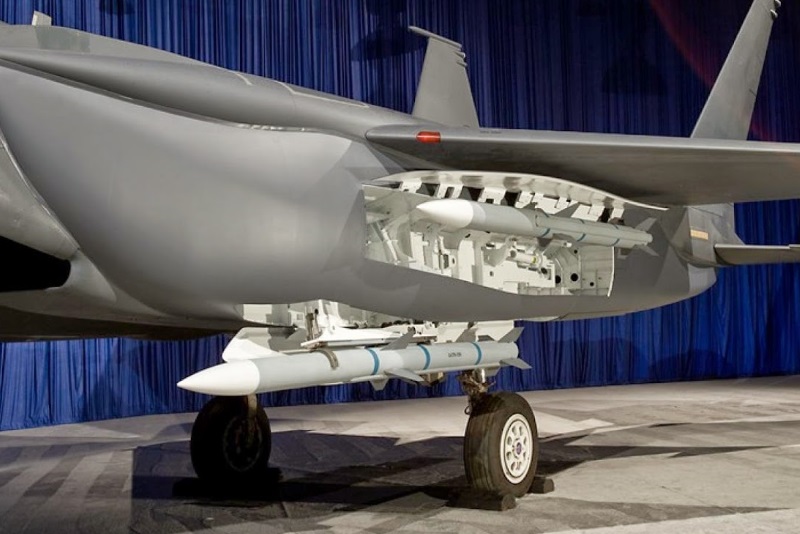
The stealth CFTs could be unbolted and swapped with conventional CFTs to permit more fuel and heavy external warload. The stealth CFTs could be obtained or license-built for retrofit to existing F-15s.
There was more to the F-15SE than simply new CFTs, with airframe changes and a layer of "radar absorbing material (RAM)". The tailfins were also canted outward by 15 degrees, providing a bit of stealth along with a little additional lift. There was no engine inlet radar protection, and the exhausts were not redesigned to lower their infrared signatures -- these measures being seen as more drastic and expensive.
Boeing made it clear that the prime target for the new Stealth Eagle was the export market, offering the latest avionics, such as AESA radar and a large-area touchscreen cockpit display. The F-15SE would also have a "digital electronic warfare system (DEWS)", developed by BAE Systems. DEWS was derived from countermeasures systems developed from the F-22 and the Lockheed Martin F-35 Joint Strike Fighter; it would be more capable and more compact, and interoperable with the Eagle's AESA system.
There was little interest in the F-15SE as such, with Boeing then moving on to an "F-15 2040C" effort, focused on upgrades instead of new production. It wasn't so much a new configuration, as a menu of possible upgrades. One facet was to expand the F-15C's weapons loadout, with a concept drawing showing an F-15C with multiple ejector racks, allowing it to carry eight AMRAAMs under the fuselage, plus four AMRAAMs -- or three AMRAAMs and an AIM-9X -- on each wing pylon, for a total loadout of 16 AAMs.
One of the motivations in up-arming the F-15C appears to be consideration of the relatively large number of AAMs a Chinese fighter force could throw at a US force, overwhelming the US force. Heavy AAM loads were an engineering challenge, however, and so the short-term upgrade would be CFTs that would allow carriage of four more AMRAAMs. Boeing began trials of an F-15C with the updated CFTs in early 2018.
Boeing didn't give up on sales of new-production aircraft to the USAF, pitching an "F-15X" from 2018, including a single-seat "F-15CX" and two-seat "F-15EX". The F-15EX concept defined an "Advanced F-15" aircraft like that of the two-seat Qatari F-15QA, with an extended service life, lower operating costs, an improved cockpit layout, a new ADCP-II mission computer, EPAWSS, and FBW controls. It could carry up to 22 AAMs, or 8 AAMs and 28 SDBs, or 8 AAMs and seven 900-kilogram (2,000-pound) bombs. The F-15CX was the same, but with only one seat.
The Air Force liked the F-15X, committing to buying eight machines, towards a total of 80. The USAF will, to keep things simple, only obtain the two-seat F-15EX; F-15C pilots will fly the new variant with the back seat empty. It will also not have CFTs, at least at the outset, indicating a focus on the air-to-air mission. It has been given the name of "Eagle II". Initial flight of the first example was on 2 February 2021.
The Air Force plans to replace the F-15C/D fleet with the F-15EX, it being more cost-effective to buy new than to keep upgrading old aircraft. There is also thought to filling out the air fleet by acquiring "loyal wingman" drones, along the lines of lightweight unpiloted jet fighters that would accompany piloted fighters on missions, but that's a speculative future at present.
BACK_TO_TOP* There have been a fair number of one-off special modifications of the Eagle. Early on, MDD developed and trialed new lightweight wings, made of graphite-epoxy composite or aluminum-lithium alloy. The new wings were an improvement, but not to the extent that they were ever adopted for production aircraft.
In the early days of the Eagle, MDD tried to promote a reconnaissance version of the aircraft designated the "RF-15", but at the time the USAF was happy with their RF-4C Phantoms and didn't bite. MDD didn't give up, however, and in 1987 the company flew a two-seater (once again, the hard-working second TF-15A) fitted with a "Reconnaissance Technology Demonstrator (RTD)" pod.
The RTD pod was a conformal pack mounted on the aircraft's centerline and could be configured to carry a range of reconnaissance systems. The Air Force didn't bite on this concept, referred to as the "F-15(R) Peek Eagle", either. About a decade later, in 1995, an F-15D was fitted with an AN/ASD-10 Advanced Tactical Airborne Reconnaissance System (ATARS) pod as an experiment, but Air Force brass decided that the F-16 would be the service's ATARS platform instead.
There was also talk about using the Eagle in the "suppression of enemy air defenses (SEAD)" role, fitted with a "radar homing and warning system (RHAWS)" to detect hostile emitters and destroy them with the AGM-88 HARM missile. Various trials of F-15s with a prominent undernose fairing and fitted with pieces of SEAD gear were performed, but the brass also decided to use the F-16 as the service's HARM shooter.
The F-15 has been used in the "aggressor training" role, with the 65th Aggressor Training Squadron (65 AGRS) formed up in 2005 at Nellis AFB in Nevada. The 65 AGRS was assigned 24 F-15s, all painted in blue or tan disruptive camouflage patterns to emulate Russian aircraft, with the 65 AGRS collaborating with the 64 AGRS, also at Nellis, flying F-16s in the same color patterns. It appears there were no special modifications to these aircraft, other than the paint jobs, though they may have carried laser scoring devices. The 65 AGRS was disbanded in 2014 due to budget cuts, though the 64 AGRS remained in operation.
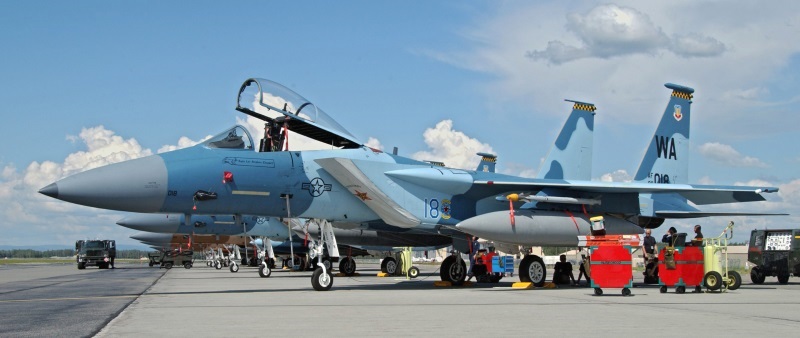
* The very first two-seater Eagle was modified under the "Short Takeoff Or Landing (STOL) / Maneuverability Technology Demonstrator (SMTD)", which was begun by NASA in 1984. As the designation indicates, the intent of the program was to develop an Eagle that didn't require so much runway and featured improved maneuverability.
The aircraft was fitted with canard foreplanes, modified from the horizontal tailplanes of the MDD F/A-18 Hornet; an "automatic landing guidance (ALG)" system; and the glass cockpit and heavier landing gear of the Strike Eagle. The canard fins were mounted at a prominent dihedral of 20 degrees and could be used differentially for flight control, but they were mostly meant to support STOL.
Initial flight of the SMTD was on 7 September 1988, with test pilot Larry Walker at the controls. After 43 test flights, the machine was then fitted with moveable, boxy "vectored thrust" engine exhausts built by Pratt & Whitney. The new exhausts could move up or down by 20 degrees and could operate as thrust reversers. The SMTD performed its first flight in this configuration on 16 May 1989, conducting 95 more test flights up to the end of the program on 12 August 1991.
The SMTD program was judged a success, though its technology was not incorporated into production F-15s. The data obtained by the program was important to the Lockheed Martin F/A-22 Raptor and Lockheed Martin F-35 Joint Strike Fighter programs, however, which were intended to replace the F-15 and F-16 respectively.
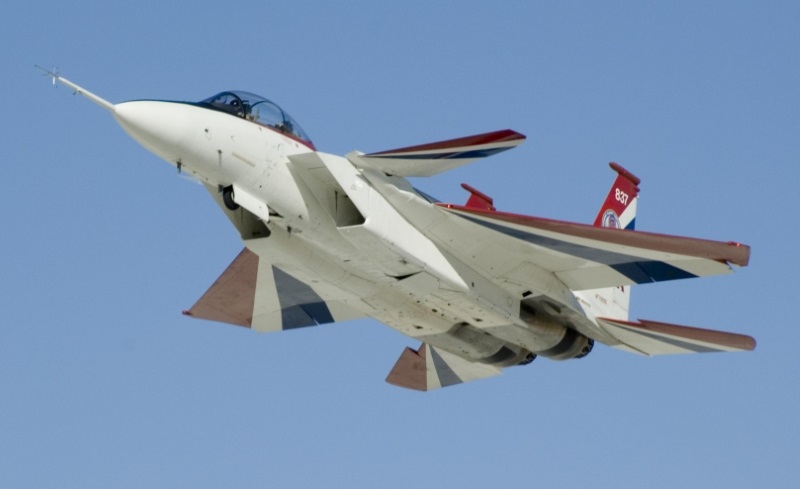
After the conclusion of the SMTD program, the same aircraft was then further modified as part of the joint USAF/NASA "F-15B ACTIVE" program. The new configuration retained the canards but featured new thrust-vectoring nozzles that can turn 20 degrees in any direction. First flight of the F-15B Active aircraft was in February 1996. Apparently this same aircraft was to be modified for trials for a tailless F-15 under the appropriately named "MANX" program, but details are unclear. This particular machine was finally retired in 2009, after providing long and excellent service.
* NASA has also operated "stock" F-15s for research programs:
* One of the more interesting experimental applications of the F-15 was as an "anti-satellite (ASAT)" interceptor. During the early 1980s, F-15s performed tests with an ASAT missile carried on the centerline pylon, with the aircraft going into a climb along a prearranged trajectory to fire the missile at an altitude of 24,400 meters (80,000 feet). The missile then went into space and released a "kill vehicle" that homed in on the orbiting target using an infrared seeker and rammed it, destroying the target through sheer kinetic energy.
The ASAT was based on the Boeing AGM-69 Short Range Attack Missile (SRAM) developed for the B-52 and B-1 bombers. The ASAT had a launch weight of 1,225 kilograms (2,700 pounds) with a length of 5.43 meters (17 feet 10 inches) and could intercept satellites up to altitudes of 965 kilometers (600 miles). The ASAT was seen as much more cost-effective and flexible than the "co-orbital" weapons developed by the Soviets and considered by the US, which involved launching a "killer satellite", using a normal satellite booster.
The F-15 was regarded as a good launch platform because of its excellent rate of climb. Following a series of tests, on 13 September 1985 an ASAT-armed F-15A engaged and destroyed the "Solwind P78-1" space science satellite, which had been launched by the US in February 1979. The satellite was well beyond its expected life, but it was still returning data; the project scientists were annoyed, and complained loudly.
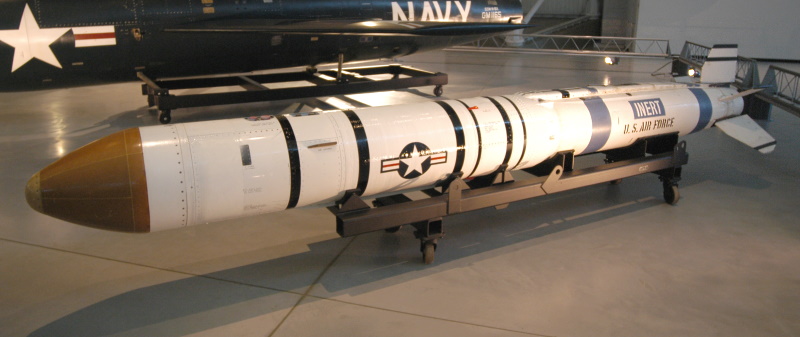
ASAT technologies have been tested since the beginning of the space race, but nobody has been eager to deploy them since it would invite retaliation in kind, resulting in the neutralization of everyone's space assets. In fact, the F-15 ASAT tests were largely in response to Soviet ASAT experiments and were at least partly intended to show the USSR that the US could respond if needed. In any case, the F-15 ASAT program never got beyond the test stage, though apparently at least some F-15s retained the wiring to carry the ASAT missile. However, in 2003 the Air Force Research Laboratory (AFRL) conducted a paper study in which the scheme was evaluated as a means of putting light satellite payloads into orbit; the idea is still floating around, but so far the F-15 hasn't put a satellite into orbit.
Another, long-standing and ongoing, use of the F-15 for trials has involved using the Eagle to carry large pods for aerial infrared testing -- with designations such as the "Beam Approach Seeker Evaluation System (BASES)", "Calibrated IR-Visible-UV Ground & Airborne Radiometric Spectrometer (CIGARS)", "Supersonic Airborne Tri-Gimbal Infrared System (SATIRS)", and "Spectral-Spatial Airborne Radiometric Infrared System (SARIS)". It is not clear if all these pods are still in service, and other aircraft besides the F-15 carried them. The pods have been used to characterize targets to support work on seekers for heat-seeking AAMs, and for IRSTs.
* In the early 1970s, MDD also produced concepts for a carrier-based version of the Eagle designated the "F-15N", or more casually the "Seagle", with arresting hook and heavy landing gear for carrier landings. Some F-15N concepts featured carriage of the US Navy Hughes AIM-54 Phoenix AAM. The admirals, prodded by Congress, looked over the F-15N schemes politely, but the Navy was working on fielding the Grumman F-14 Tomcat as their BVR interceptor at the time, and there was never really much chance for the F-15N unless the Tomcat program collapsed entirely.
It is worth realizing that this interservice rivalry went both ways to an extent. The USAF had found the McDonnell F-4 Phantom an excellent aircraft, but Air Force blue-suiters had always felt a bit of discomfort over adopting a Navy aircraft as their first-line fighter. The F-15 represented something of a declaration of independence. Very well, Navy officers no doubt felt in response, the Air Force could play with its own toys; the Navy had their Tomcat.
In the 1990s, while the USAF was moving on the F-22 Raptor program, MDD proposed a modernized version of the F-15 for the air superiority mission as a cheaper alternative to the expensive F-22. The improved Eagle was designated the "F-15XX" -- not to be confused with the later F-15X proposal -- and was to feature improved performance and "stealthy" characteristics. It only had a chance if the F-22 program collapsed, and despite various difficulties the Air Force pushed ahead with the Raptor program. The F-15XX was a nonstarter.
Other unbuilt variants included the "F-15U", which was an F-15E modified for a United Arab Emirates (UAE) requirement; and the "F-15U (Plus)", which as its name implies was a much more heavily modified version of the F-15U for the UAE requirement, featuring such options as a bigger wing, built-in targeting system, and possibly vectored-thrust exhausts. The MDD proposals didn't make it into the finals of the competition.
BACK_TO_TOP